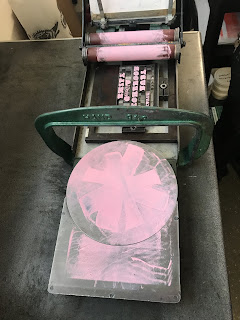Letterpress originated in the 15th century and was the primary source of printing for 500 years. Today it has been replaced by offset printing. Letterpress is a highly elegant way of printing which is why it is still often used to formulate invitations, business cards etc.
'Letterpress printing, also called Relief Printing, or Typographic Printing, in commercial printing, process by which many copies of an image are produced by repeated direct impression of an inked, raised surface against sheets or a continuous roll of paper. Letterpress is the oldest of the traditional printing techniques and remained the only important one from the time of Gutenberg, about 1450, until the development of lithography late in the 18th century and, especially, offset lithography early in the 20th.' https://www.britannica.com/technology/letterpress-printing offset lithography
'Letterpress can produce work of high quality at high speed, but it requires much time to adjust the press for varying thicknesses of type, engravings, and plates. Because of the time needed to make letterpress plates and to prepare the press, many newspapers have changed to offset printing.' https://www.britannica.com/technology/letterpress-printing offset lithography
- Draws are laid out with letters next to each other that are most common. Vowels have the largest areas and E has the most space in the draw due to it being the most common/used letter within the English language.
- Capitals are in alphabetical order within the draws as they are only used at the beginning of a sentence. U & J stand alone because they were the last letters added to the alphabet.
Chasers - the frames
Composing Stick - Helps set the type and is easy to transport
REMEMBER - All type is made out of led, therefore, it can be poisonous for us so hands need to be washed straight away after handling it.
Leading - For the line spacing
Furniture - Wood and metal is used to slot everything into frames. Through centre force the type stays in place inside the frame.
At the bottom of each letter theres is a groove and letters are also backwards so they print the correct way. For this reason extra care needs to be taken when handling letters such as lowercase 'b' and 'd'.
- Anything that is not raised will NOT be printed.
- It is easier to start with longer line lengths and to stick with one length of leading.
- When setting out type it is easier to work upside down going from left to right. This is easier to set all of the design out.
- It is important that you don't treat the chase as your page as it is entirely down to you how you line up the paper with the letters.
- Only one colour can be used on the smaller letterpresses due to the spinning ink palette. Alternatively on the larger letterpress multiple colours can be used creating gradients.













No comments:
Post a Comment